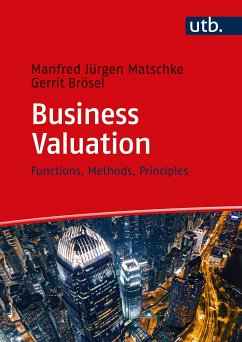

Alle Infos zum eBook verschenken

- Format: PDF
- Merkliste
- Auf die Merkliste
- Bewerten Bewerten
- Teilen
- Produkt teilen
- Produkterinnerung
- Produkterinnerung

Hier können Sie sich einloggen

Bitte loggen Sie sich zunächst in Ihr Kundenkonto ein oder registrieren Sie sich bei bücher.de, um das eBook-Abo tolino select nutzen zu können.
And assigns them to the relevant function of business valuation. Breaking down business valuation into three stages is a major step toward improving the transparency of the process. The steps introduced in this book are 1. Determination of relevant data acquisition, 2. Transformation of relevant data in a value, 3. Use of the determined value. A key aspect of this textbook is its analysis of the valuation process from the perspective of both buyer and seller. Ultimately, the book will present readers with the key principles of functional business valuation, which if it had been applied more…mehr
- Geräte: PC
- ohne Kopierschutz
- eBook Hilfe
- Größe: 6.66MB
![Controlling Schritt für Schritt (eBook, PDF) Controlling Schritt für Schritt (eBook, PDF)]() Gerald PilzControlling Schritt für Schritt (eBook, PDF)31,99 €
Gerald PilzControlling Schritt für Schritt (eBook, PDF)31,99 €![Neue Betriebswirtschaft (eBook, PDF) Neue Betriebswirtschaft (eBook, PDF)]() Neue Betriebswirtschaft (eBook, PDF)49,99 €
Neue Betriebswirtschaft (eBook, PDF)49,99 €![Marketing Concept - The St. Gallen Management Approach (eBook, PDF) Marketing Concept - The St. Gallen Management Approach (eBook, PDF)]() Thomas BiegerMarketing Concept - The St. Gallen Management Approach (eBook, PDF)28,99 €
Thomas BiegerMarketing Concept - The St. Gallen Management Approach (eBook, PDF)28,99 €![Bewertung immaterieller Vermögenswerte (eBook, PDF) Bewertung immaterieller Vermögenswerte (eBook, PDF)]() Ulrich MoserBewertung immaterieller Vermögenswerte (eBook, PDF)87,99 €
Ulrich MoserBewertung immaterieller Vermögenswerte (eBook, PDF)87,99 €![Nachhaltigkeitscontrolling (eBook, PDF) Nachhaltigkeitscontrolling (eBook, PDF)]() Ulrich SailerNachhaltigkeitscontrolling (eBook, PDF)48,99 €
Ulrich SailerNachhaltigkeitscontrolling (eBook, PDF)48,99 €![Business Plan Schritt für Schritt (eBook, PDF) Business Plan Schritt für Schritt (eBook, PDF)]() Serge RagotzkyBusiness Plan Schritt für Schritt (eBook, PDF)31,99 €
Serge RagotzkyBusiness Plan Schritt für Schritt (eBook, PDF)31,99 €![Jahresabschluss Schritt für Schritt (eBook, PDF) Jahresabschluss Schritt für Schritt (eBook, PDF)]() Jörg WöltjeJahresabschluss Schritt für Schritt (eBook, PDF)25,99 €
Jörg WöltjeJahresabschluss Schritt für Schritt (eBook, PDF)25,99 €-
-
-
Dieser Download kann aus rechtlichen Gründen nur mit Rechnungsadresse in A, B, BG, CY, CZ, D, DK, EW, E, FIN, F, GR, HR, H, IRL, I, LT, L, LR, M, NL, PL, P, R, S, SLO, SK ausgeliefert werden.
- Produktdetails
- Verlag: UTB GmbH
- Seitenzahl: 398
- Erscheinungstermin: 19. April 2021
- Englisch
- ISBN-13: 9783838555201
- Artikelnr.: 71187534
- Verlag: UTB GmbH
- Seitenzahl: 398
- Erscheinungstermin: 19. April 2021
- Englisch
- ISBN-13: 9783838555201
- Artikelnr.: 71187534
- Herstellerkennzeichnung Die Herstellerinformationen sind derzeit nicht verfügbar.







